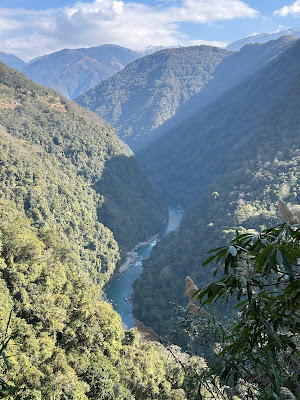Well this blog still seems to be running despite several warning emails from Google that the blog hosting is to be cancelled unless I sign up to a hefty monthly subscription fee with Google Business. In the meantime, I should report that I have just come back from a great trip to the Dulong river valley in Yunnan. This is not directly Joseph Rock related, because he only mentions the 'Tarong' river briefly in his National Geographic article about when he was visiting the Salween. In the article 'Through the Great River Trenches of Asia' (1926) he briefly refers to the "Kjutzu ... a simple primitive tribe who live across the divide who, the Chinese say, live in trees like monkeys". Other explorers talked about rumours of a tribe of pygmies who lived in the remote valley of the Tarong river that flows in to Burma.
Even in the 1980s, Chinese photographer Shen Che described the 'Drung' people as a 'primitive tribe' of about 4000 people who lived a subsistence farming life in the Dulong valley. The valley was only accessible by horse caravan trail from the Nujiang, which was closed by snow and ice in the winter months.
Of course since then the Dulong has opened up to the outside world. First a rough road was built in the 1990s, and this was gradually upgraded to a paved highway in the 21st century, and more recently(2015) a tunnel has been bored through the highest mountain section at around 3-4000 m altitude to make this an all-year passable highway.
The main settlement of the Dulong valley, Kongdang, is now a small centre for hotels and restaurants, and even has an EV charging station. The Dulong people are now assimilated into mainstream China's development - they no longer wear the traditional stripy carpet clothes or sport crossbows. Most families have SUV cars and take advantage of the 4G mobile network. You might still find an elderly lady with the unique Dulong facial tattoos, but they are wheeled out for the tourists and charge a fee for posing.
I got there in one of vans that run from the centre of Gongshan to Dulong town (100 RMB), leaving at 11am daily and taking about three hours (the road is currently only open from 11.30 for a few hours daily to enable further upgrading work to be done). I stayed at a decent hotel (Hapang Pubu) in Dulong township for about 200 yuan a night. The friendly manageress arranged for a driver to take me on a day tour up and down the valley for 700 RMB for a day.
I had
a great guide who took me on the epic trip down the canyon to the Burma
border, where there is a scenic waterfall and some guesthouses (but no
Burmese people, the border is totally sealed off, like a modern day Iron
Curtain). He told me that the local people had benefited from the visit of Xi Jinping a few years ago. As part of the subsequent poverty alleviation programme, the local people got a free house to replace their rickety old wooden shacks ( a few still survive) and they also receive 2-3000 RMB a month as a living allowance in return for developing and preserving the local green environment.
With my guide I also visited the north of the valley, which is much colder and sparsely forested, more similar to a Tibetan landscape, as the road eventually continues into Tibet. I went as far north as Xiongdang, and beyond to the new 'tourist theme village' Kelaluo where there are new guesthouses and a water feature - not too remote any more.
The trip was part of a recce to see how easily it now is to travel in remote parts of China. The answer is - easier than ever. The Dulong is now readily accessible from Kunming via Baoshan (3 hour high speed train) then a 4 hour bus to Gongshan. No special permits needed and no police hassles except for a universal document inspection when entering the Nujiang at Liuku.
It helps enormously to have AliPay and WeiXin/WeChat functions set up for payments and hotel bookings, train and bus tickets etc, but people still accept cash.
As part of my trip I also revisited Gongshan and Bingzhongluo in the Nujiang. I stayed in a swish Lavande hotel in Gongshan for a mere 200RMB ($28), which is cheaper than a bunkbed in a Sydney backpacker dorm. I also found that Bingzhongluo has had a makeover, with the main street's former dirt road now a smart thoroughfare lined with posh shops and hotel similar to somewhere like Dali.
Overall, this trip made me realise that in my 30 years of sporadic travel in Rock's foosteps there have been as many or even more dramatic changes in the places of interest as in the previous decades since Rock's time! I will write more about my latest trip and the interesting folk I met in further posts ...





No comments:
Post a Comment